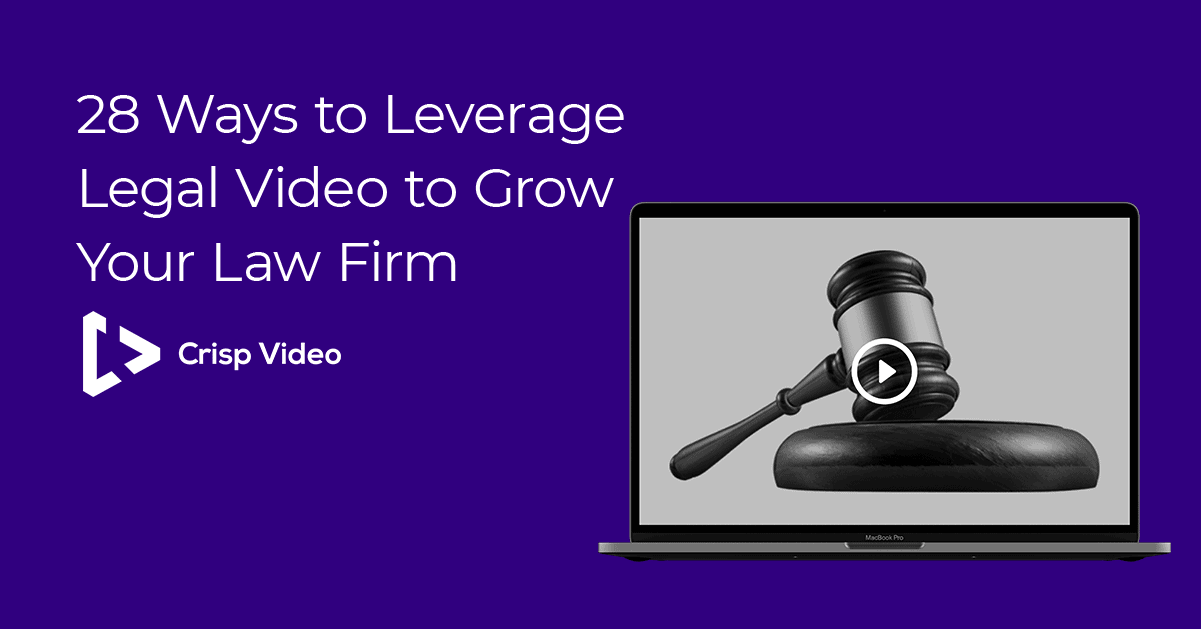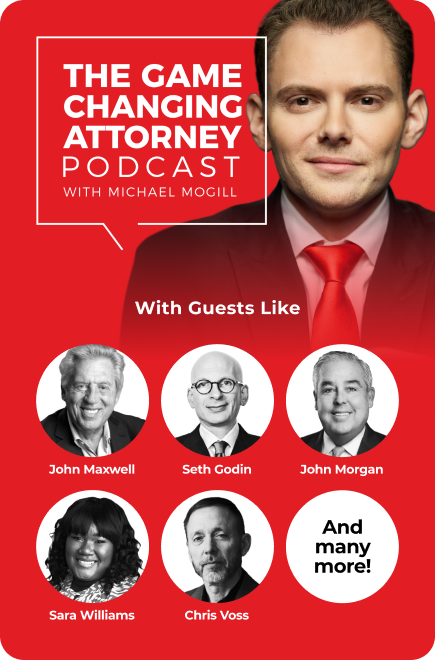If you’ve made the decision to produce a legal video for your law firm, congratulations — you’ve made the right choice. Video has been shown time and time again to drive massive results to online marketing campaigns, is a proven strategy to enhance your brand, and can establish a direct connection with potential clients.
Here are a few of the more surprising statistics about video:
- Adding video to emails can boost click-through rates by 96%
- 90% of users say videos are helpful in the decision-making process
- Videos can boost landing page conversions by 80%
- Average online video consumption is up to 84 minutes per day
Videos have become a dominating force in online activity, and companies are responding by making their content more visual and interactive.
However, getting your legal video produced is only half the battle. To achieve dramatic results, you have to distribute it to the right channels.
Your video won’t boost revenue or bring in clients if no one sees it, so you have to ensure that you’re taking advantage of the many ways you can use your video if you want to see the most success.
This includes distributing your video through both traditional and nontraditional channels, promoting it on all social media, and ensuring you’re incorporating the best practices of video marketing.
We’ve created a list of 28 ways to leverage legal video to grow your law firm below, so you can keep track of which channels you should use to distribute your video to bring in clients, increase revenue, and drive results.
Check it out:
- Upload your video to Facebook natively
- Upload your video to YouTube
- Run a YouTube ad campaign
- Embed your video on your website
- Use your video as your Facebook page header (no longer available as of April 2021)
- Showcase the video in your office
- Include your video in your team’s email signatures
- Use your video in your hiring process
- Add your video to your Avvo profile
- Run a paid Facebook campaign with your video
- Include your video on your LinkedIn company and personal profiles
- Run a LinkedIn ad campaign
- Email videos to contacts in various lifecycle stages in an automated drip campaign
- Share your video to your Google My Business profile
- Run a web retargeting campaign
- Share your video to your Facebook personal and business pages
- Embed your video on geographic-specific or unique landing pages
- Share your video in an email newsletter
- Share your video as an Instagram post
- Run your video as an ad on Instagram
- Send your video to referral partners as an introduction tool for potential clients
- Post your video on Twitter
- Play your video at community events that you sponsor
- Run your video as an ad on television
- Use still shots from your video in various spots on your website
- Make practice area-specific videos for custom landing pages
- Create a custom URL or QR code for the video that you include on direct mail pieces so recipients can watch your video
- Mail out a video brochure that plays for the recipient
#1: Upload your video to Facebook natively
Video content shared on social networks generates 1,200% more shares than text or images combined, and videos on Facebook receive a total of 8 billion views per day. While it may seem obvious to share your video to Facebook, there is an important distinction between sharing a YouTube link on your firm’s Facebook page versus uploading it natively.
Videos that are uploaded natively to Facebook achieve 10x higher reach than shared links, and Facebook’s algorithm rewards native videos because they’re trying to carve out their own space in the video industry.
Another important benefit of native uploads? Native Facebook videos will autoplay, so potential clients don’t even have to click “play” to watch your video — it will play automatically as they scroll past it.
Facebook videos are proven to have more social engagement than their counterparts on YouTube, and the massive amount of data Facebook has on its 2.5 billion users allows you to develop targeted advertising campaigns towards your ideal client persona.
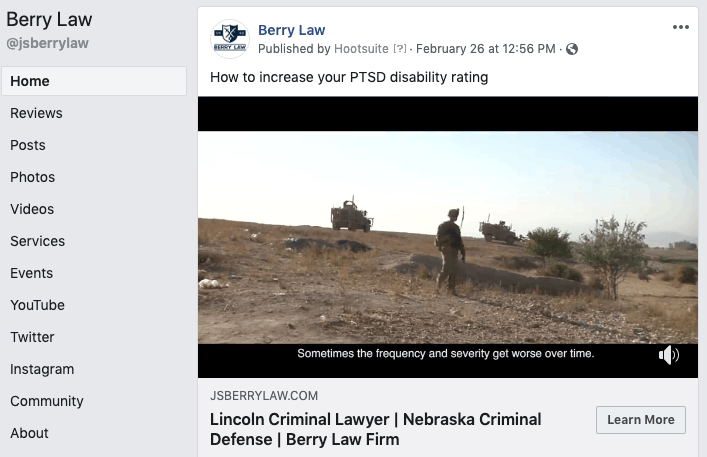
This means that you can guarantee your video will show up in front of people who have visited your website, opened your emails, or engaged with past social media posts — thereby increasing your chance that they’ll come back as a client!
Top Tip: After uploading, pin the post to the top of your company page so it’s the first thing people see when they navigate to the firm’s profile. Ensure that you’ve included accurate captions for people who may be either watching the video without sound or have hearing difficulties.
#2: Upload your video to YouTube
Just because Facebook won’t autoplay YouTube videos doesn’t mean you should shirk the opportunities present in YouTube video marketing.
YouTube has more than two billion active users and is considered the world’s second largest search engine, and we’re on track to see 82% of all global internet traffic being video streaming and downloading by 2022. To make the most out of YouTube, though, it requires more than just uploading a video to your channel and calling it a day.
Videos are a fantastic tool to boost your firm’s SEO and generate more traffic to your website, especially through backlinks.
The basic rule of thumb for YouTube is to never upload a video without creating tags, titles, and descriptions. This allows your video to be found in search results and will generate more traffic than if you had created a title without any additional information.

While a single video can direct an influx of traffic to your website, consistent content is the best way to generate proven SEO results and increase success.
It’s recommended to post a video once per week with content that’s directly related to the search terms your ideal clients are looking for. This can be completed through SEO and keyword research, and over time your video campaign will drive more traffic and higher conversion rates to your site.
The best way to monitor a YouTube campaign once it’s been initiated is to analyze and optimize your search traffic results on YouTube.
Initial keyword research is a fundamental step in your video campaign, but it’s just as important to monitor your search traffic after your campaign launches to see which videos are showing up in searches. This will allow you to decide which videos are most and least successful, empowering you to make strategic pivots in your video marketing strategy if necessary.
Ultimately, YouTube is the place to go for video content. The same trend that’s been seen around all of social media applies to YouTube as well: organic posts are trending down, and putting money behind your videos is the way to get exposure and results. Any content you post is most likely going to sit around with single and double digit view counts, taking months or even years to accumulate a few hundred views.
With paid promotion of your videos, they’ll be exposed to a wider audience, found easier, and ultimately lead to the brand exposure you’re looking for.
#3: Run a YouTube ad campaign
Much like how LinkedIn has its unique ability to target based on job title (see #12 below), YouTube offers a unique benefit due to its exclusive focus on video. Video draws people in more, which means they spend more time on the site and engaging. This engagement also allows for a better way to qualify their interest based on the amount of a given video they actually sat and watched.
YouTube offers several styles of video advertising, but we prefer to focus on two in particular:
- Bumper ads are a short video ad format, designed to allow you reach customers broadly and increase awareness about your brand by using a short, memorable message. Bumper ads are just 6 seconds or less, and viewers can’t skip the ad.
- In-stream ads run before, during, or after other videos on YouTube or across Display Network sites, games, or apps. These ads may also run on YouTube videos that are embedded on other sites. After 5 seconds, the viewer has an option to skip the ad.
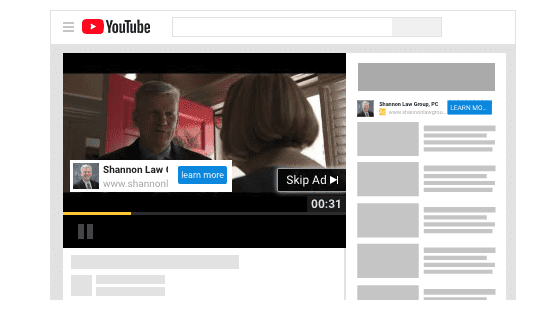
If I stopped watching your video after 5 seconds, it’s safe to say the content wasn’t interesting or relevant to me.
If I stayed and watched your entire video titled “What to Do When I Get in an Auto Accident,” I’m likely a much more interested prospect.
Another benefit is that video is more impactful as a medium, but on YouTube, you only pay for the ad when someone chooses to watch at least 30 seconds of your video ad.
This means that none of your advertising budget is being wasted on those people who only watch 5 seconds and then click away.
Ad campaigns like these are YouTube’s primary revenue source, so they like to make it a relatively simple process:
- Once you have your video, you’ll be prompted to choose your ad type. As a law firm, you’ll be best served by Standard campaign, which is geared towards views, awareness, and conversions rather than, say, downloading something or buying an item.
- You’ll then set your budget and customize what geographic areas you’d like to target, and a host of advanced settings that let you customize to a very high degree.
- The actual ad creation is all handled through YouTube’s ad platform, which is made especially easy by the fact you can just post the link to the video you want to run as an ad. Set your specifications, write a short headline and description, and you’re almost done.
- Setting the budget is a key step that will directly influence the number of projected views your video may receive. Budget will naturally vary from law firm to law firm.
- Finally, you can further define the audience you would like to target with the video. As you can see in the below image, YouTube lets you get very specific if desired.
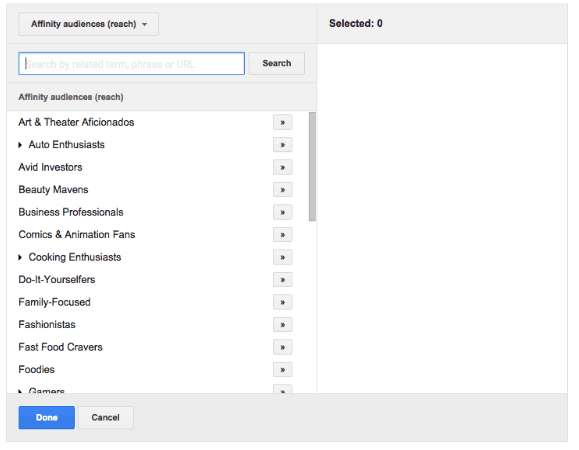
For tips and tactics to audit the way you currently advertise on YouTube and tweak your strategy to boost authority and increase engagement, check out The YouTube Advertising Guide for Attorneys. Download this exclusive guide below!
#4: Embed your video on your website
The homepage of your website delivers the first impression of your firm to potential clients.
Embedding your video on your website provides immediate, engaging imagery for visitors and a direct path to the resource designed to establish an emotional connection that text alone can’t provide. In fact, the human brain processes video content 60,000 times faster than text, which means the amount of information we can consume in a two minute video vastly overpowers the information we could absorb from the standard “About Us” section on a website.
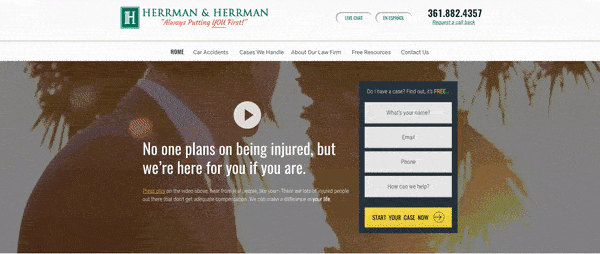
Video can serve as a powerful differentiator in the decision-making process. If a potential client is trying to find an attorney to represent them, they’ll more than likely visit multiple websites before making a decision.
To put this in perspective, the average person will visit 38 different websites when booking and planning a vacation, a relatively low-stakes decision.
When deciding on legal representation, a decision with much higher stakes, chances are they’ll visit even more websites when making a decision on which person is going to represent them in a fight for their legal rights.
Here are a handful of impactful legal videos produced by Crisp:
If someone is visiting upwards of 40 websites trying to decide on an attorney, is your website going to make the cut? You have to make sure that you put something unforgettable in front of them, and that’s where legal video comes in.
When embedding your video on the website, embed it above the fold, meaning the video is visible without having to scroll down on the website. This not only increases the chances of your video being seen, but is also proven to boost SEO rankings, as Google rewards websites with enticing visual/video content. Your law firm video marketing campaign will complement your domain’s SEO.
Moreover, be sure to include a schema markup on your legal video, which is a simple piece of code that allows search engines to gather data on the video. It sounds complicated, but it simply allows search engines such as Google to access basic information on the video — as Google’s algorithm won’t be able to index the visual content, you’re providing detailed information on your video for them within the schema markup.
#5: Use your video as your Facebook page header
In 2017, Facebook recently rolled out an exciting new feature that allowed users to upload videos as their Facebook header (the banner displayed behind the profile photo).
As of April 2021, this feature is no longer available.
Known as a video cover, this feature would silently autoplay as soon as someone hit your Facebook page. While there were a few restrictions on this feature, it was a great option for a law firm looking to improve the aesthetic of their company page and potentially increase engagement with your social media.
Uploading a video cover was a quick and easy process, but may require some edits to your video. Here were the requirements for uploading a video over to a Facebook page:
- The video must be between 20 and 90 seconds long.
- The video resolution must be 1080p.
- The video must maintain a resolution of 820 x 462 pixels to achieve the right aspect ratio — without this, part of your video will be cropped out.
Because the video limits were only 20-90 seconds, it was recommended to put together a shorter cut of a full-length video so that your audience would see the most important aspects of your video rather than just half of one video. If this popular feature returns to Facebook, we recommend creating either a 30-45 second cut of your firm’s brand video or something creative that highlights your team and office.
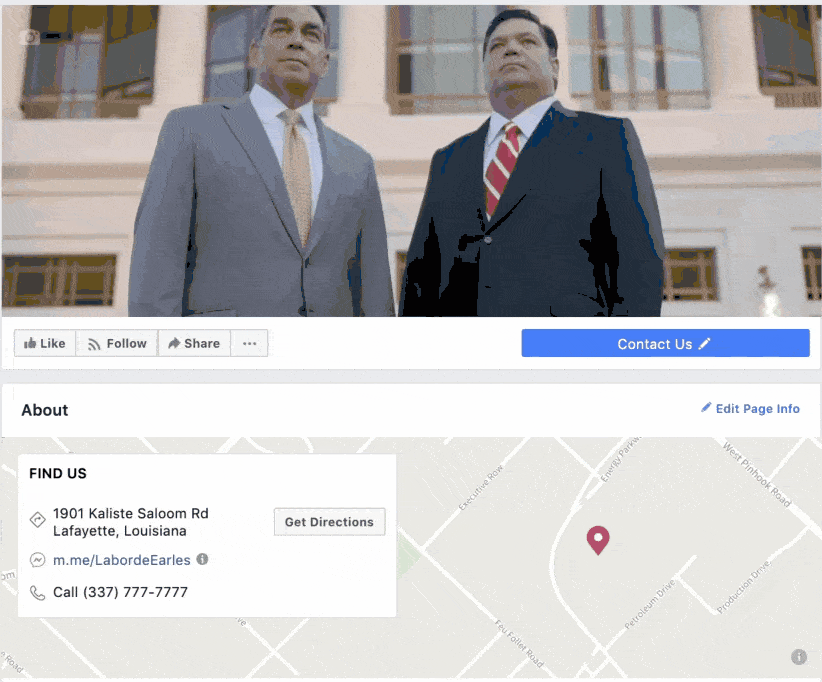
This would serve as an exciting and unique introduction to your firm as soon as someone lands on your company Facebook page, thereby increasing the odds that they’ll convert into a client on your website.
Top Tip: To complement any engaging features on your Facebook page, make sure your staff is active on Facebook Messenger so you’re able to quickly answer any inquiries and avoid losing out on a potential client who reaches out via Facebook.
#6: Showcase the video in your office
Waiting for appointment times is a common (and often unpleasant) experience for most of us. To compensate for this, give your clients something interesting to watch while they’re waiting for their appointment.
Just as a video on your website offers the first impression of your firm, a video playing in your office as clients come in is an engaging way to solidify the image of your firm in their mind.
What would clients think if they saw a video like this playing in your office?
If your firm’s office has a reception area or lobby, having video content running on a TV in that area will provide clients with information about your firm, practice area, attorney profiles, client testimonials, and more.
Simply looping a brand video over and over will get old quickly, so if you choose to go this route, we recommending including fresh video content on a regular basis. This could include a compilation of FAQ videos, testimonials, and specific case studies that exemplify your expertise in your market and reinforce past clients’ positive experiences in the eyes of potential new clients.
Top Tip: These videos will more than likely be playing without audio, so make sure that your video content has accurate subtitles so your clients don’t miss out on valuable information!
#7: Include your video in your team’s email signatures
Although email platforms do not currently have the capability to directly embed videos, you can take advantage of this underused strategy by embedding a link to your video under every staff member’s email signature with a clear Call-to-Action, such as, “Check out our latest video to learn more about our firm!”
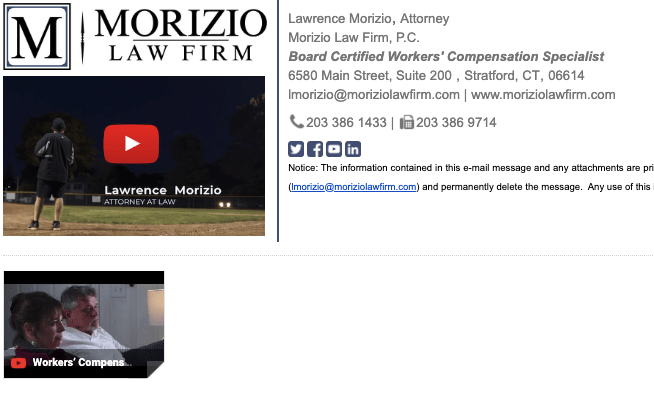
When they click the link, they’ll be redirected to a specific landing page you’ve established — whether it’s a video portfolio or specific page with your video — where you should include additional calls-to-action (CTAs). This provides curious browsers the chance to learn more information from your latest video following an email conversation, and also provides them the opportunity to book a consultation if they haven’t already.
You could include the video as a link within the email signature, or as a video thumbnail that links to the video — images are more engaging, but if your staff signatures include their headshots already, it may cause for clutter in email dialogue.
Video can increase email click-through by almost 300%, so this is yet another tactic to increase the amount of traffic coming to your site and ensuring everyone you interact with is exposed to your firm’s freshest content!
#8: Use your video in your hiring process
Interested in hiring top-notch candidates with a genuine desire to work for your firm? Show them your video. Your brand video or a more focused firm culture video communicates your brand and your values, while also humanizing your firm in a way that most job descriptions can’t.
Embed a brand video or a “Meet the Team” video on your Careers page, link to your videos on all of your hiring posts, and include a video signature on all interactions with potential candidates.
Here’s a great law firm example:
Communicating your unique value proposition to potential hires will attract an influx of candidates with a true desire to work for you because your video has established an emotional connection with them.
Don’t just tell them what your firm does. Show them why you do it and how they can be a part of those efforts. Employees want to know that their work has value, and this is easier to accomplish when you clearly communicate the value you strive to offer within your firm.
We’ve had clients who have received emails from highly qualified attorneys looking to join their practice after viewing their video without even listing an open position.
Expanding a team allows you to grow your business quickly and efficiently, so you can worry about the important things: your clients and their cases. To truly have a successful team, though, you need the right team members, and strategic video content can help attract that talent.
#9: Add your video to your Avvo profile
Want a winning Avvo attorney page? Add your video to your profile.
Maximize your Avvo rating and exposure by linking your YouTube videos to your Avvo site. When potential clients navigate to your Avvo profile, they’ll find a portfolio of video content directly under your headshot, right above the message link!
Just think — if a client sees a high-quality, engaging legal video on your Avvo site, wouldn’t they be more compelled to message your firm right after watching it?

Your Avvo rating increases based on their unique algorithm, which takes into account factors like content publication. Adding videos, articles, and blogs to your Avvo site will boost your rating on an ongoing basis. The higher your score, the more likely it is that you’ll show up first (or close to it) in search queries completed through Avvo. Publishing the video (or multiple videos) to your page is a great way to improve your profile and boost your score.
#10: Run a paid Facebook campaign with your video
The best way to generate real results from a Facebook video is to create a targeted campaign around it. While uploading video natively to your company page will drive traffic, it won’t guarantee that it’s getting in front of the right people (by that, we mean people who are more likely to become clients).
96% of social media marketers consider Facebook to be the best advertising platform, with good reason — with 2.5 billion users, Facebook has a massive audience, with plenty of options for you to narrow down your targeting to only include your ideal client persona.
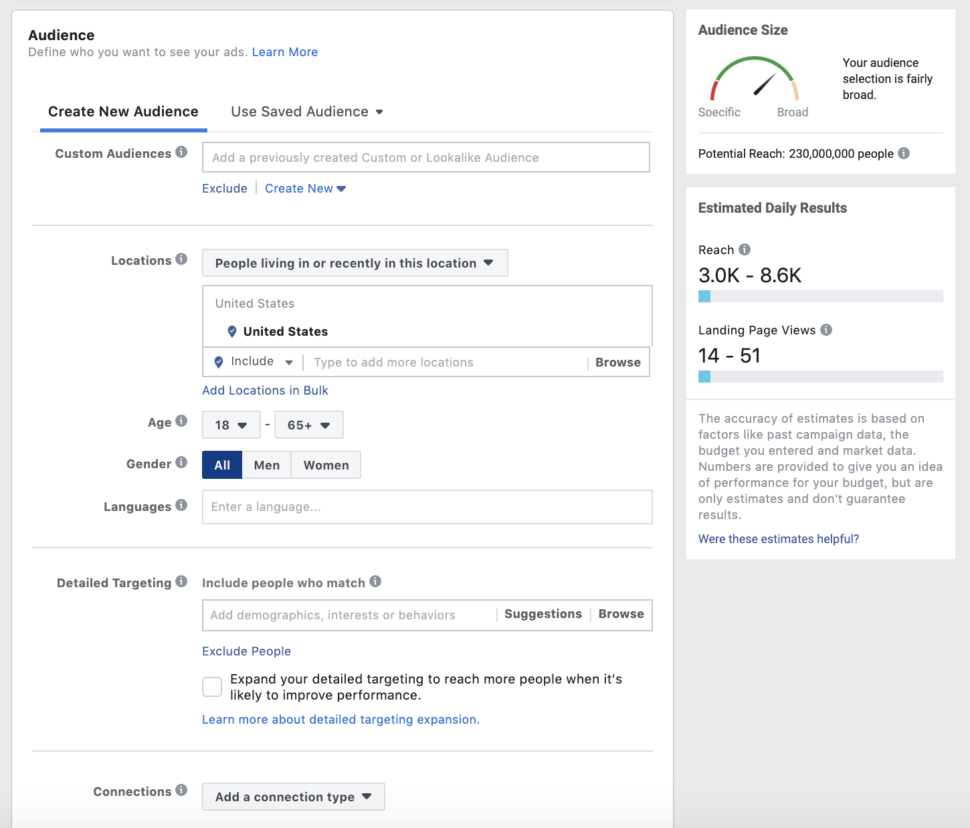
The average person spends 37 minutes a day browsing through the extremely popular social network, but without a paid ad campaign, there’s no way to know that they’ll end up on your company page.
Facebook ad campaigns are highly customizable. You can create an audience based on age, gender, location, ethnicity, what kind of car they drive, what phone network they use, and even the likelihood that they’ve searched for legal help in the last 12 months.
That is a huge asset sitting right at your fingertips.
You could do one of two things: you could boost your original video, which simply places the post higher on your audience’s newsfeeds and increases engagement, or you can use Facebook’s powerful advertising tools to create direct, targeted campaigns to a specific audience.
Each option has its virtues, and your decision may depend on your level of comfort with social media advertising. But if you want real results we would recommend running a targeted ad campaign.
Facebook ad campaigns allow you to monitor and optimize ads to ensure you are generating increased traffic to your website and promoting elevated brand awareness for your firm. You can experiment pairing your video with different captions, CTAs, and landing pages. If you have more than one video, you can run multiple campaigns at the same time to different audiences.
Check out this sample traffic blueprint to visualize how audience-building works:

This sample traffic blueprint demonstrates how, between the video ads that you’re running online and the use of your website, you can build distinct audiences based on who has viewed your videos and who has visited your website. You can then continue to target these people with ads based on their previous engagement with you as they move towards actually making a decision about hiring you.
Build audiences wherever you can. And remember, these platforms want to make it as straightforward as possible. For instance, Facebook offers a robust audience-building tool right in its ads platform:
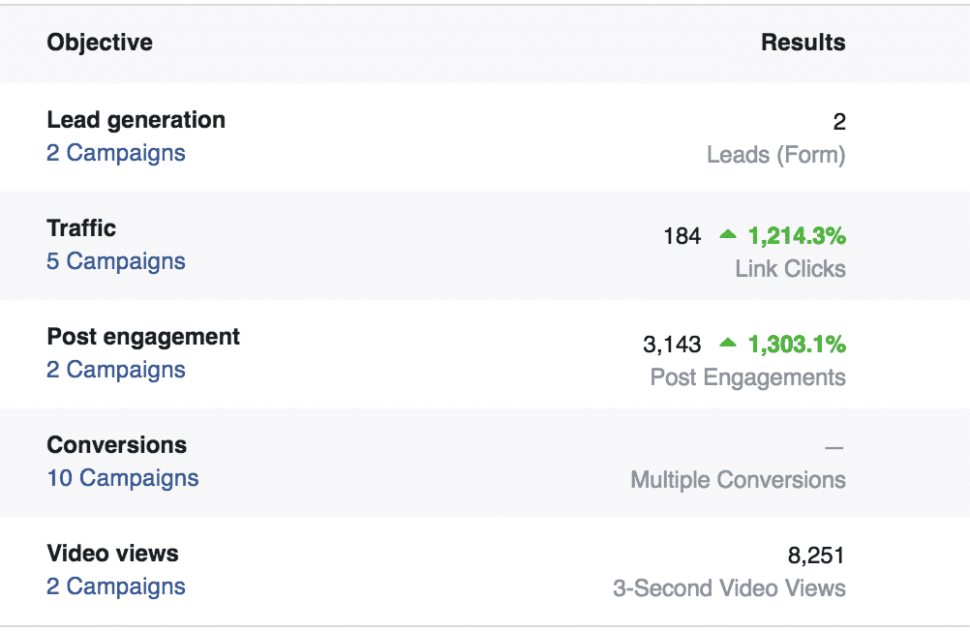
The Facebook audience network is a seemingly endless well of potential client revenue. You just have to figure out where to start drilling. Our recommendation? Build a lookalike audience by uploading a list of your current clients to your business account — Facebook will handle the rest by building a list of users who share similar characteristics.
By targeting lookalike audiences, you’re putting your ads in front of people who are similar to the people who have already become your clients.
More than 7 million businesses run ads on Facebook every month. Will you be next?
Ready to dive into setting up and optimizing your audience targeting for Facebook ads? We’ve got you covered. Download a copy of our exclusive Facebook Ad Targeting Guide for Law Firms below!
#11: Include your video on your LinkedIn company and personal profiles
While LinkedIn falls behind Facebook and YouTube on traffic and audience size, it’s still a relevant social platform to advertise and promote content on.
Remember that tidbit about visiting 38 websites before making a decision? Well, your LinkedIn company or personal profile may be one of those sites — so it has to have the right content on it.
In addition to just reaching potential clients on LinkedIn, this career-focused platform also allows you to reach other attorneys by targeting based on job title like “Attorney” and “Managing Partner.” Marketing yourself to other attorneys is the best way to produce the most qualified leads of all: referrals.
Just like Facebook, LinkedIn has begun promoting video content within their newsfeeds in an effort to boost its stature as a professional social network. While advertising content on LinkedIn isn’t as robust as Facebook, it still has a diverse array of targeting options including profession, gender, age, location, and more. You can include keywords in your captions and video that are optimized for search and boost overall engagement with your company page.
A quick way to add video to your LinkedIn: add the YouTube link to the “Add Media” section of your personal and company profile:
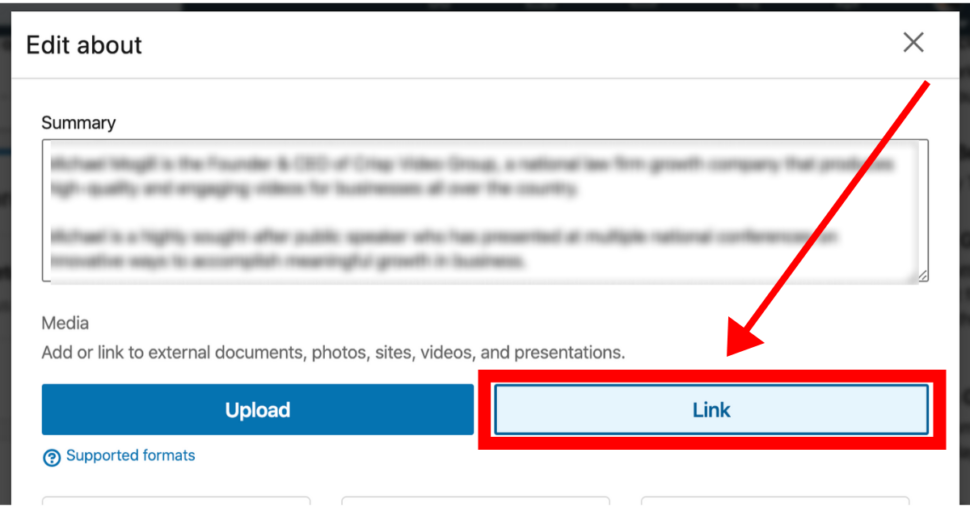
You can also include the video linked within a status update and include a relevant or compelling quote from the video to increase engagement.
See this type of LinkedIn post in action:
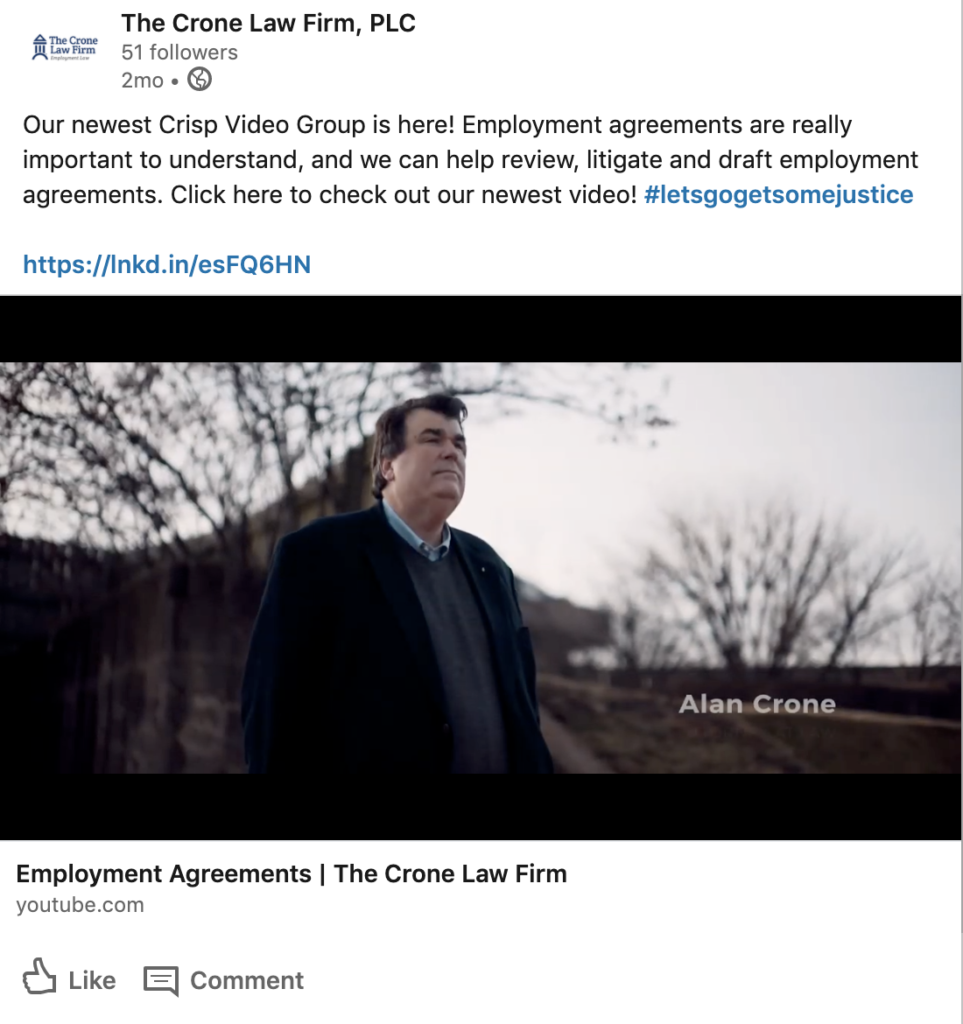
LinkedIn is rated as the most trustworthy social network, which means you can include testimonials and other content that will carry more weight than they may on Facebook.
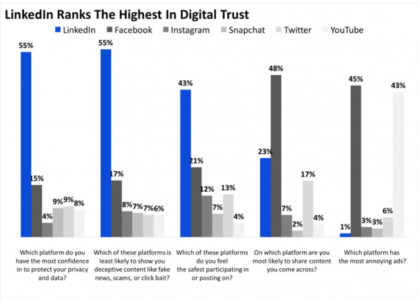
#12: Run a LinkedIn ad campaign
LinkedIn offers a unique marketing opportunity that isn’t as readily available on the other social media platforms. LinkedIn’s explicit professional focus enables you to target users based on their title and job description. There’s no guarantee that someone will give any indication of their professional status on Facebook, but that is the whole point of LinkedIn.
Through a targeted ad campaign on LinkedIn, you can accurately market to other attorneys and generate a more powerful brand awareness and ultimately get cases referred to you. A referral is the most qualified possible lead, so a well-executed LinkedIn ad campaign can have a huge positive impact on your firm’s bottom line.
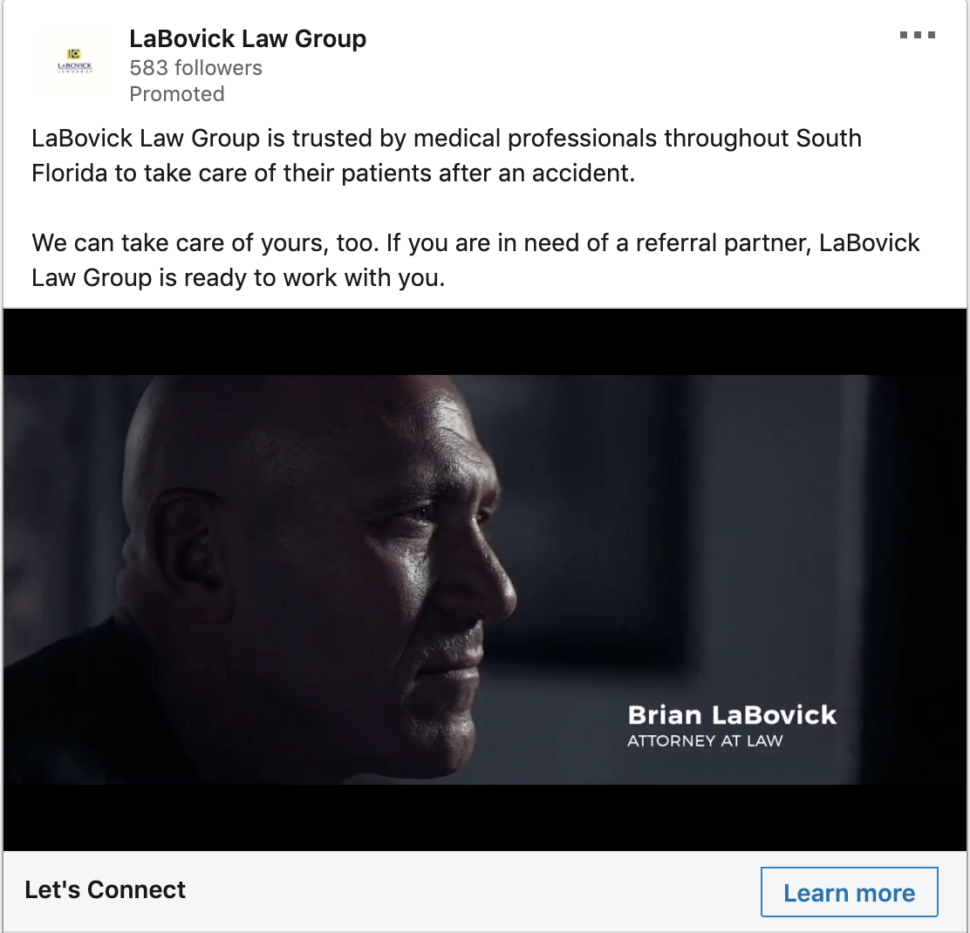
LinkedIn’s campaigns operate on the funnel concept of someone moving from Awareness to Consideration to Decision when deciding to hire you. When you start your campaign you can choose your objective based on which portion of the funnel you’d like to focus on.
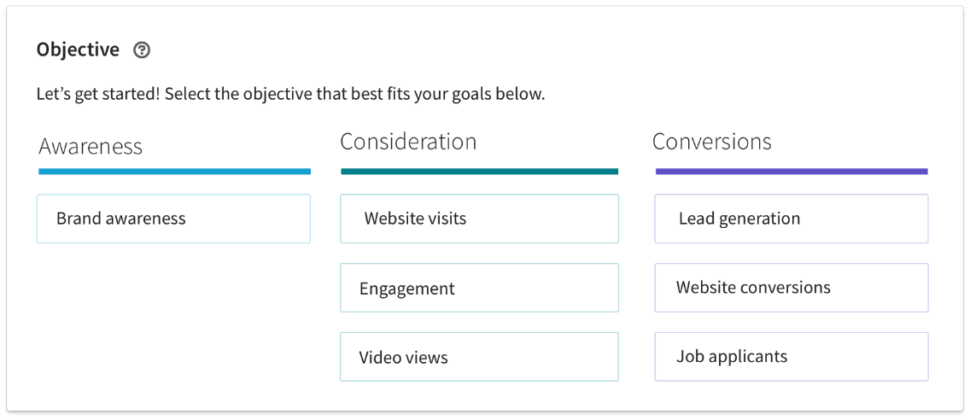
From there you can navigate through a straightforward interface to describe and build your target audience, select your video ad format, set your budget for the campaign, and finally set up the actual ads.
Want more information on multi-channel marketing, including which platforms your ideal clients are spending their time and how to get started on each one? Download our free Multi-Channel Marketing Guide for Attorneys below!
This resource covers the basics of leveraging multiple channels to connect with prospective clients and provides actionable strategies for launching and optimizing ads on a number of major social channels.
#13: Email videos to contacts in various lifecycle stages in an automated drip campaign
Potential clients can be massively aided by video content as they move through the marketing lifecycle. One way or another, every client you’ve ever had has gone from never hearing of you, to trusting you with a serious legal matter.
Today’s marketing lifecycle is composed of five steps:
- Awareness
- Interest
- Evaluation
- Decision
- Loyalty
From spaghetti sauce to cruise lines to pickup trucks, every consumer goes through these steps when evaluating any good or service.
As you accumulate more and more contacts, you can target them with different kinds of videos in various emails depending on how far they’ve progressed towards actually becoming a client.
An email drip campaign is a (usually automated) series of emails you send to contacts with the goal of working them towards some sort of action. This typically involves an incremental approach to communicating with prospective clients.
A very simple drip campaign might consist of a welcome email, a second email that shares a blog post you wrote on a certain legal topic, and then a final email that encourages the person to schedule a consultation.
Below is a rudimentary workflow in Hubspot, a popular email marketing platform, that shows the emails, what triggers someone as a recipient, and when they will actually be sent.
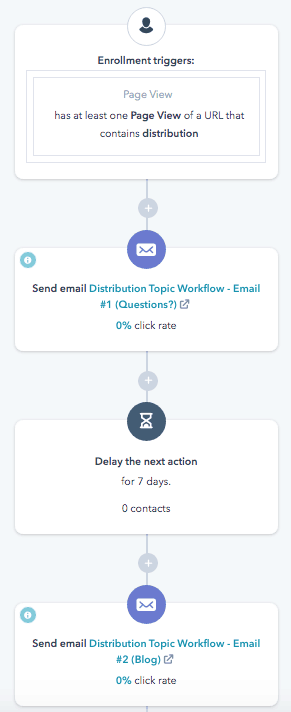
Here are a few other email marketing tools to consider:
Early on in the decision-making process, your audience may not even know they have a problem. Top-of-funnel digital ads and frequently asked question (FAQ) videos like this one are effective at this stage:
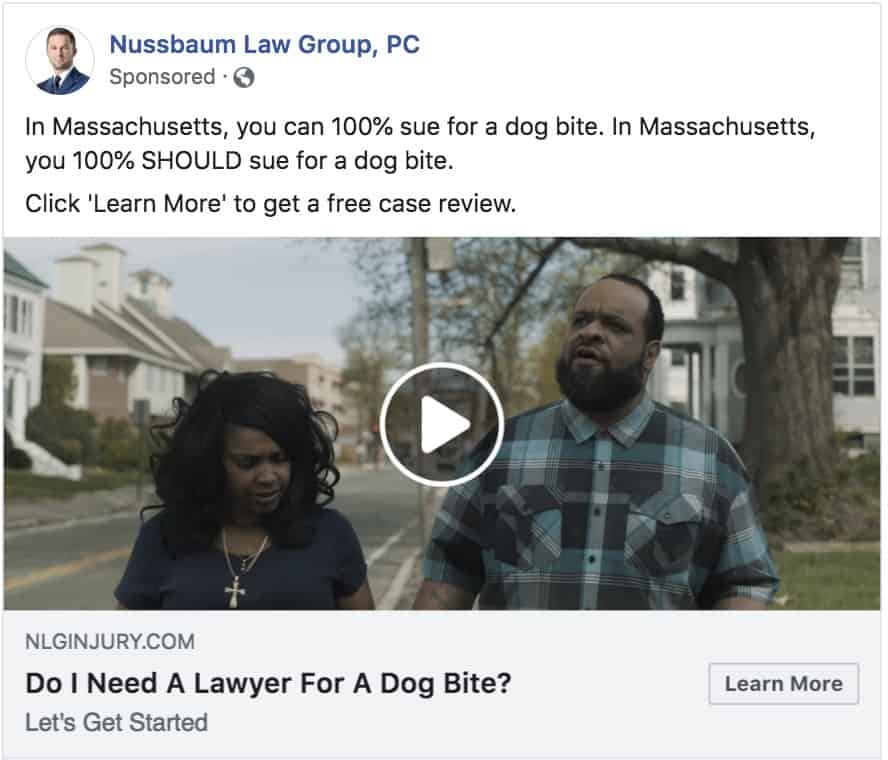
If a user visits your website, they’re considered to be in the Interest stage. They know they have a problem, they need someone to help them, and your brand occupies some portion of their headspace. During this stage your prospective client is looking to get to know you and your firm better, and is likely forming an emotional connection to your content, your brand, and ultimately to you as a person. Users in the Interest stage are best aided by practice areas and attorney profiles.
The Evaluation stage is one step further, when the prospective client is looking for logical justification for the emotional connection they have developed with your brand. Client testimonials, case studies, and success stories provide crucial social proof during this fact-finding stage.
Now for the Decision. At this stage, your prospect is on the verge of hiring you, but they may have lingering doubts about their decision. It is essential to positively reinforce the feelings that led to their decision, eliminate friction between the contact and your team, and give them a good experience from the first interaction.
Your intake process and your front-facing staff are your most important assets as prospective clients reach out with intention to make their decision. Make sure you have prompt, friendly, and helpful follow-up emails for this stage, and consider sharing your brand video or core values again to reassure this individual that they are making the right decision by choosing you.
Emailing your contacts who are at various lifecycle stages is a foundational marketing strategy, and the added video will help move them forward as you provide them with emotionally resonant and visually engaging content.
#14: Share your video to your Google My Business profile
Google My Business is a huge component of legitimizing your firm online. If you don’t already have a profile set up, do so as soon as possible.
To review, Google My Business is that handy box on the right-hand side of the results page whenever you perform a Google search for a certain business. If you went and Googled your favorite restaurant right now, you’ll almost certainly see that box with some pictures, reviews, their location on a map, their hours of operation, and their website and contact information.
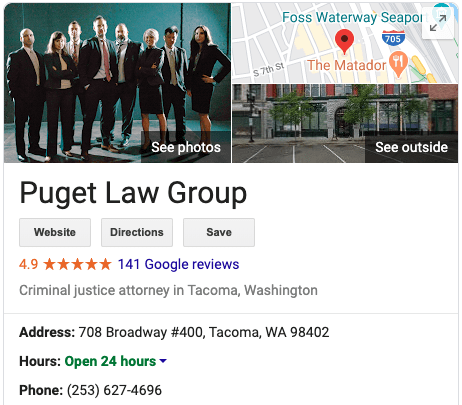
You can make this information even more robust by adding in a brand video to really provide the full experience for anyone clicking through and trying to learn more about you and your firm.
It’s important to view the Internet as a tool for providing context. Many of the people glancing at your Google My Business profile have maybe only heard your name before, or never even heard of you at all. Having a wealth of content, including video, that shows who you are and makes a memorable impact is the key to maintaining and growing your brand.
#15: Run a web retargeting campaign
Retargeting people on the web means you can show ads to people who previously visited your website or engaged with your content. This is a huge benefit to your marketing efforts as it can create an entire tracked population of people who have expressed some level of interest and familiarity with your brand.
You can then build off of that interest by retargeting potential clients. Here we see a video ad that a potential client would see on their Facebook feed after visiting the Nussbaum Law Group website:
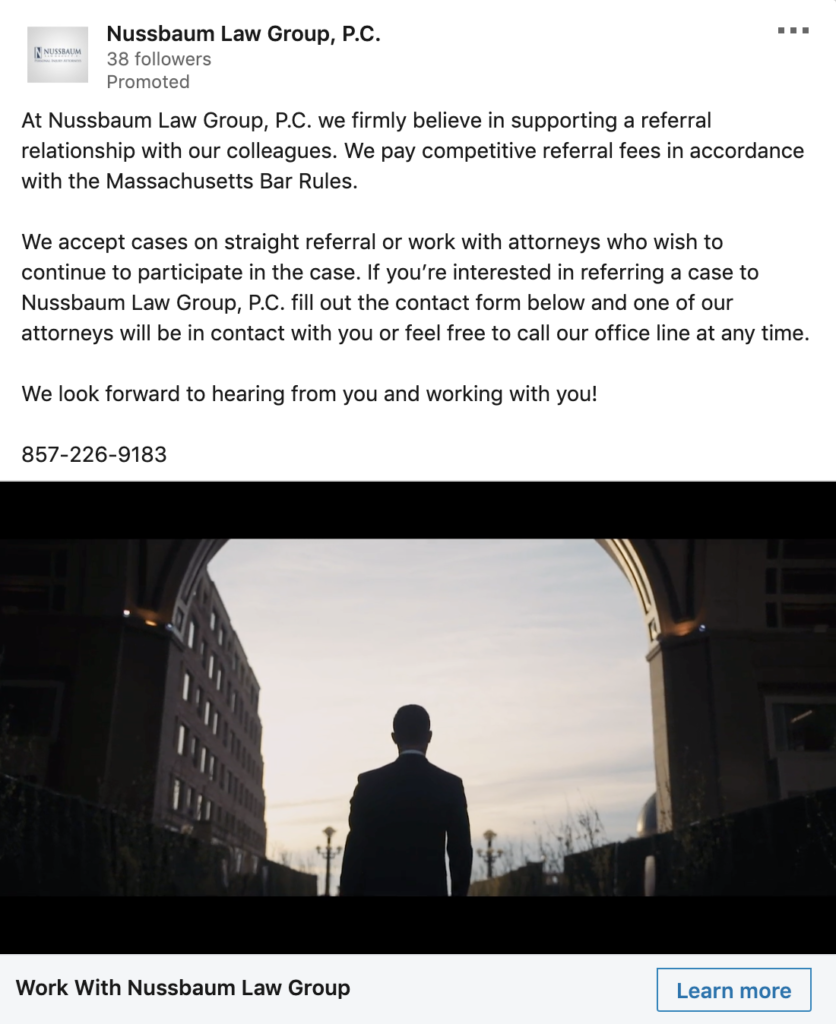
The idea here is that someone visits your site, joins your audience of interested individuals, and then is repeatedly shown your video content as ads to maintain your brand’s presence wherever they go on the web.
This keeps your law firm top of mind and will encourage users to return to your site when the timing is better and they are ready to make a decision.
Check out this downloadable guide that gives you a comprehensive look into each phase of the new buyer’s journey! This free resource will go into depth on how consumers are choosing legal representation today, the role of emotion and logic in decision making, and how to connect with prospective clients every step of the way.
#16: Post your video to your Facebook personal and business pages
A foundational step to branding yourself and maintaining consistency across all your channels is to upload the video to both your Facebook personal page as well as your business page.
Facebook has up to 2.45 billion users, so you want to make yourself available to the largest user base on the entire Internet.
If you don’t want your video to get buried under all of your other posts, you can pin it to the top of your timeline by using the Pin to Top of Page option in the top right corner. By making your video a recurring, immediate presence on your page, you can make a great first impression with every visitor and provide a memorable moment in their online activity.
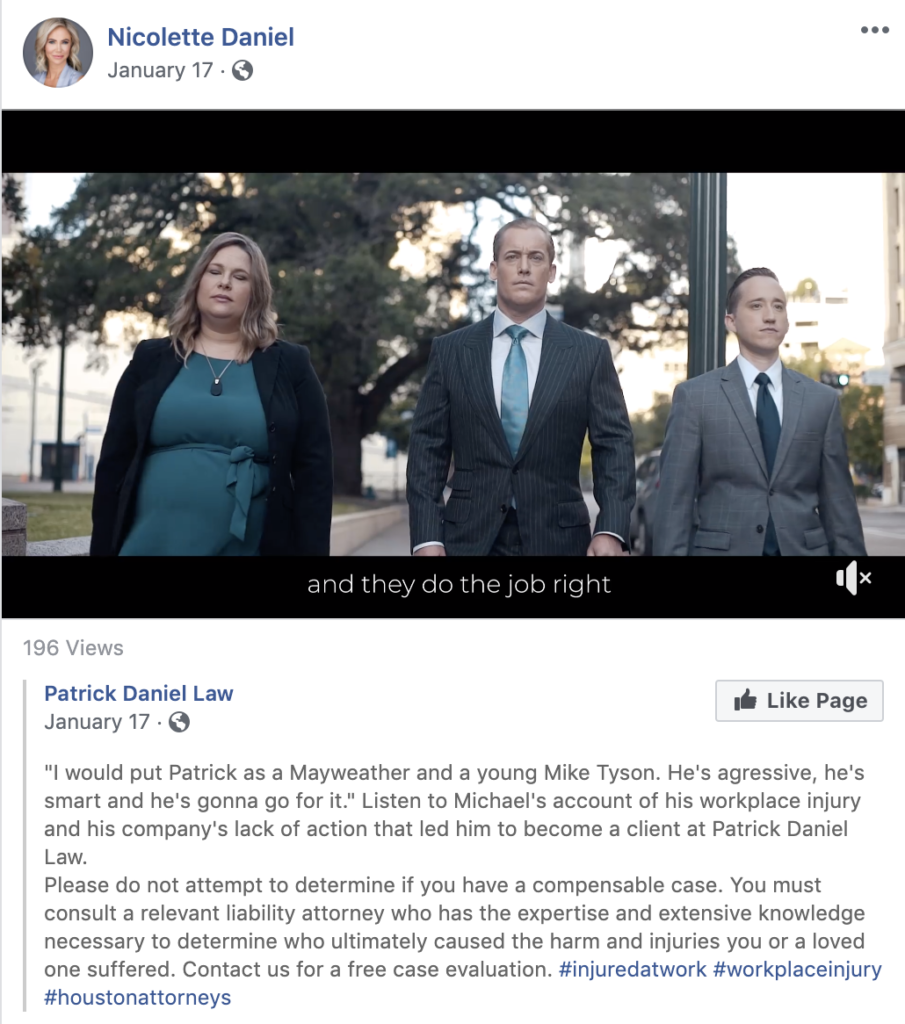
#17: Embed your video on geographic-specific or unique landing pages
A landing page is a dedicated page on your law firm’s website that is focused on a single conversion goal. Simply put, a landing page is where a user “lands” after clicking on a link.
Landing pages are very simple, straightforward, and devoted to encouraging a single specific action from a user. In the legal industry, this action is typically filling out a contact form or perhaps downloading an ebook the firm has put together on a certain topic.
Take a look at this landing page for Pittsburgh personal injury firm Chaffin Luhana:

There’s no limit to the number of landing pages you can make. A family law firm can have an ad campaign about divorce, an email about child custody, and a client testimonial video about adoption all link to separate, practice-area specific landing pages.
Embedding your video on these pages helps to keep branding consistent and provides a huge amount of value to someone who is very close to choosing you to represent them. No paragraph or slide show is going to match your firm’s video in the same amount of space.
You can learn more about how to leverage landing pages for your law firm here.
#18: Share your video in an email newsletter
Email newsletters are a great way to maintain a presence and nurture relationships with all of your contacts. Whether they’re past clients, people who came to you but you ended up referring elsewhere, fellow attorneys, or just members of your community who subscribed to your mailing list, people reading and engaging with your newsletter is always good for your brand.
Including your video in the newsletter will get your firm’s branding out to a large, interested audience.
Video is engaging, and people are more inclined to investigate and watch the entire piece of content.

Remember, you typically can’t actually embed your video in an email as you would on a website, but there’s an easy way to still grab people’s attention:
- Take a snapshot of an interesting frame of your video.
- Insert the snapshot into your newsletter as an image.
- Link the image to your video either on your website or YouTube channel.
#19: Share your video as an Instagram post
Instagram has over a billion monthly active users and high levels of engagement. Making sure your video content is available on Instagram is foundational to building a cohesive brand.
This is especially true if any sizable portion of your clients are age 34 or below, as 71% of all Instagram users fall into that age range.
Remember that Instagram’s interface is based largely on squares. This means that your video (and still images) will need to be formatted for square viewing rather than the more typical rectangular format you see on TV.
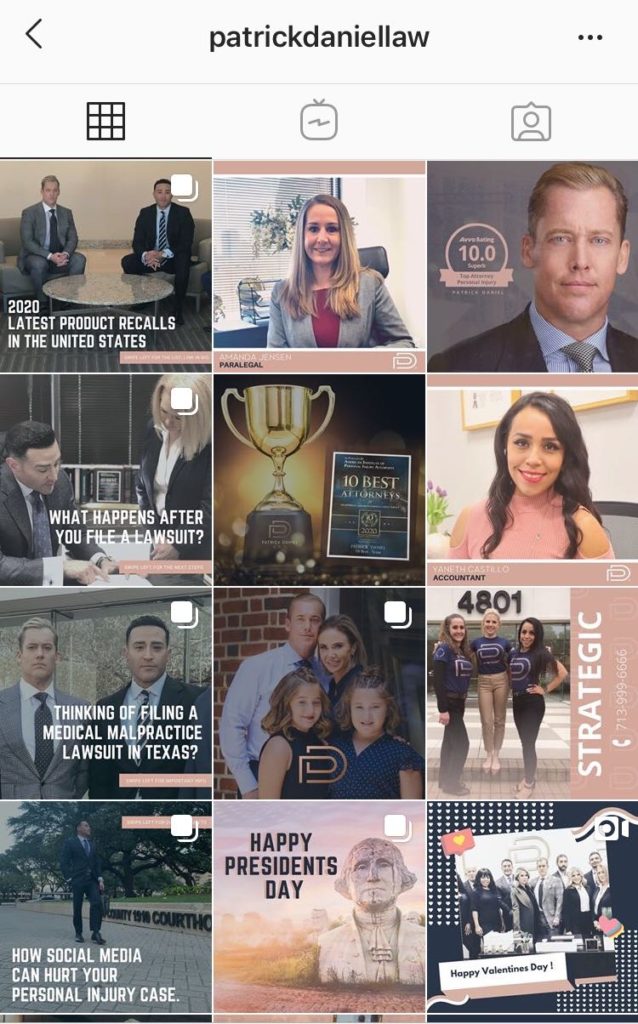
#20: Run your video as an ad on Instagram
By running video ads on Instagram, you can get the same visually immersive quality as photo ads — with the added power of sight, sound, and motion. You can also share videos up to 60 seconds long in landscape or square format.
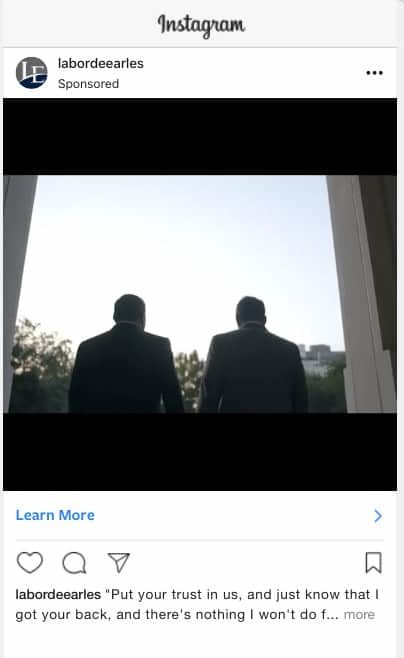
Since Instagram is owned by Facebook, both platforms use the same advertising platform, so if you have any prior experience running ads on Facebook (or if you’ve read #10 of this guide), you’ll feel right at home.
One huge benefit of Instagram compared to some other social media platforms is that it’s exclusively focused on consuming images and video. This allows your ad to be a more seamless part of every Instagram user’s experience and make a greater impact.
More than 2 million advertisers use Instagram to reach the 1 billion people who actively use the social network. At the same time, there’s been an 80% increase in time spent watching Instagram videos.
The most popular style of video ad on Instagram is the In-Feed ad. This is the ad the best encapsulates that “seamless” angle we mentioned above. They have the look and feel of a standard post, but they’re a paid promotion raising the brand awareness of your firm to a targeted audience.
Instagram combines well with other image and video-focused social media platforms when it comes to leveraging video. While you’ll reach plenty of people just on Instagram, having a more comprehensive, multi-channel approach and leveraging your video across Facebook, YouTube, and LinkedIn as well will drastically increase your reach. You can see what one of these fully-managed social media campaigns can look like here.
Looking for actionable strategies to set up, optimize, and analyze profitable Instagram campaigns for your law firm? The Essential Instagram Advertising Playbook is your guide! Download this exclusive resource below!
#21: Send your video to referral partners as an introduction tool for potential clients
A 2-3 minute brand video is the absolute best method to quickly humanize yourself, demonstrate your unique value, and feature client testimonials while also being emotionally and visually engaging.
This makes a brand video the perfect introduction tool to equip all of your referral partners with. They can share a single link and generate an entire conversation’s worth of emotional impact and engagement.
Referrals are qualified leads, but they’re not obligated to pick you just because someone else suggested they give you a call. That suggestion would be much more effective if it was accompanied by a well-produced, narratively driven video.
Here’s an example from McDonald Worley, whose marketing strategy includes a campaign hyper-targeted at potential referral partners:
#22: Post your video on Twitter
Twitter has 330 million monthly active users and its entire format encourages a high amount of engagement and sharing of content. Video in particular drives a lot of brand awareness and positive brand sentiment on Twitter.
Twitter also lets you easily pin posts to the top of your profile so your video will never get buried by your other tweets. This is a great place to position your law firm’s brand video or a 30-second version to introduce visitors to your Twitter profile to your firm, who you are, and what you stand for.
The volume of short-form content on Twitter is massive, as many users utilize the platform as a live feed or commentary. For this reason, it’s crucial that whatever you post on Twitter effectively grabs the user’s attention and pulls them in for an engaging content experience.
Here’s an example of a law firm leveraging video on Twitter to create an attention-grabbing Tweet:
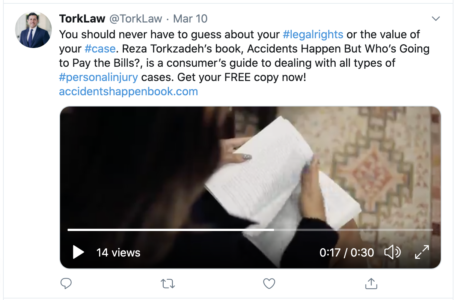
For several quick tips and strategies to use when sharing your videos on Twitter, read our guide here.
#23: Play your video at community events that you sponsor
Sponsoring community events is a great way to establish yourself in your town or city and build a sense of trust and goodwill with the people who might someday need your help. Since videos are such a powerful storytelling medium, highlighting your community involvement through video is a great way to spread awareness in an emotionally compelling format.
For instance, Howard Spiva of Spiva Law Group in South Carolina produced an entire video about his “Heads in Helmets” safety program that he champions for children in his community.

However, you can take even your in-person involvement at community events up a notch by incorporating video content that tells your law firm’s story. You can enhance this live experience by playing your brand video at the beginning or conclusion, or even on a loop depending on the venue.
Remember: all touchpoints people can have with your brand is a positive for you and your business. Just because you’re outside the confines of the internet and social media doesn’t mean you need to leave your video content back at the office.
#24: Run your video as an ad on television
We talk a lot about online media here at Crisp, but it’s entirely possible that television is a viable option in your market (or you’re like some of our clients who have had a large presence on television for decades).
It’s not cost-effective to buy a 3-minute chunk of ad time for your brand video, so you’ll have to operate in the 30-second or 60-second increments that TV is known for.
Fortunately, we’ve found that the same approach of emotional connection and establishment of value will still works with the 30-second time constraint. You can see an example for yourself below.
With some smart editing, that 3-minute video can still convert clients online while the 30-second version builds your brand awareness in your ideal clients’ living rooms.
#25: Use still shots from your video in various spots on your website
For many firms, adding a new legal branding video to their marketing efforts can signal a new era for their firm’s image and perception. The tone and imagery from the brand video can then overlap with other design elements from your website, mailing etc.
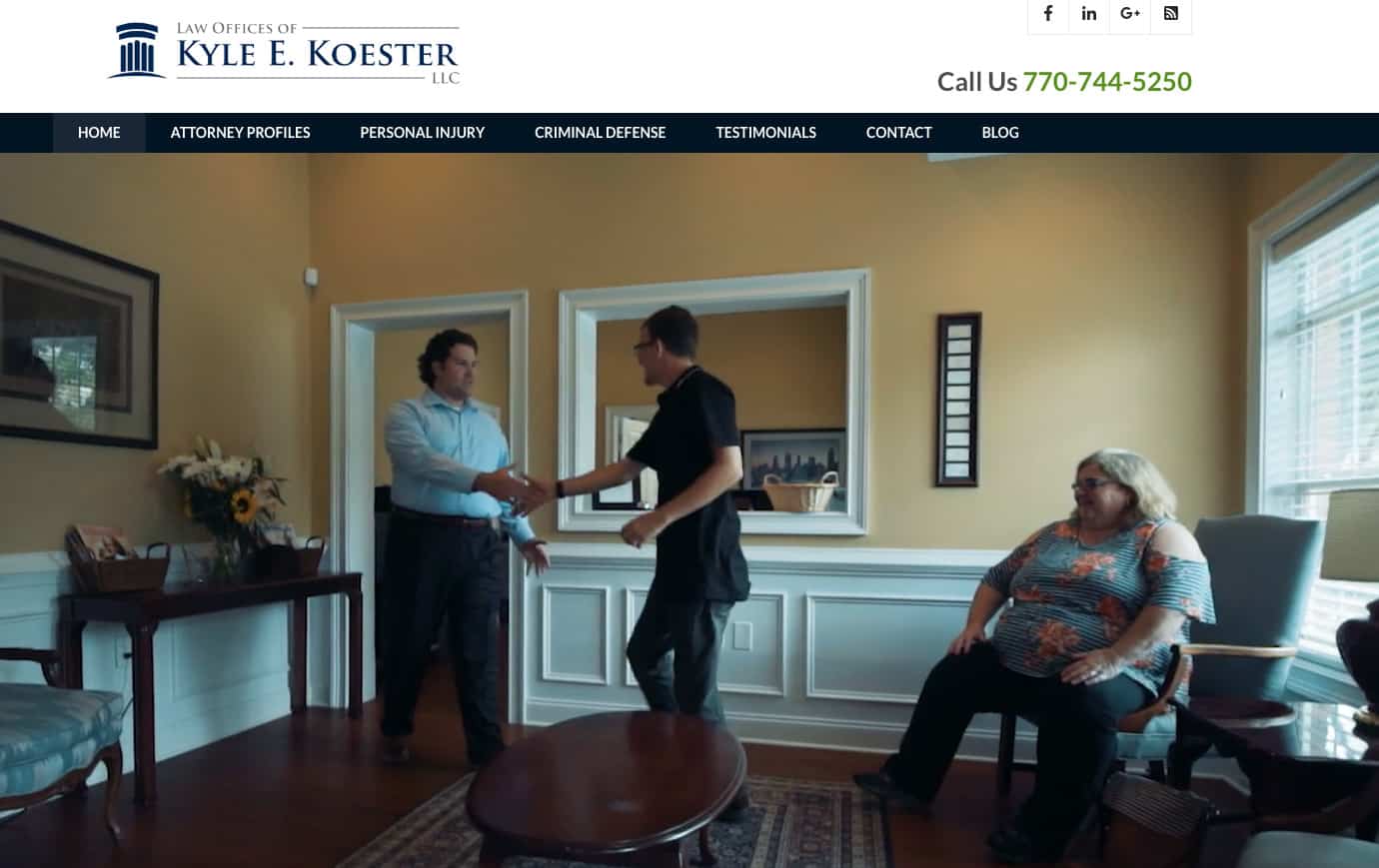
Not only that, but a professionally-produced video is bound to be full of impactful shots that you can capture as still images to leverage in your website, social media, and even print materials. This can either be accomplished through taking screenshots right on your device, or leveraging the high-def snapshot features available on many popular video players.
The opportunities are endless!
#26: Make practice area-specific videos for custom landing pages
We touched on custom landing pages earlier in #17 when we recommended embedding your brand video in each of your custom landing pages.
For an extra level of customization, you can have each landing page correlate to a separate practice area with its own unique video. This helps to establish the value that you bring to the particular legal niche that applies to the potential client.
This strategy would tie in perfectly with a targeted ad campaign that focuses on one particular practice area or specialty. In today’s legal landscape, consumers want to be in control of their decision-making journey, and a big part of earning the trust of prospective clients is personalization.
With a practice area video relevant to your audience, ad copy that speaks directly to them and the challenges they’re facing, and a landing page that continues to nurture that relationship and assure the visitor that you are an experienced expert who understands their specific pain points — your conversion rates are bound to increase.
Here’s an example of a juvenile practice area video that would be the perfect candidate for a hyper-targeted landing page to drive results:
#27: Create a custom URL or QR code for the video that you include on direct mail pieces so recipients can watch your video
Direct mail is experiencing a resurgence. Technological advancements have allowed for more creative pieces of mail to be printed at lower prices. Once they arrive, they contrast nicely with the overload of digital marketing the recipient is bombarded with every day, which can lead to high open rates.
Direct mail does have one key drawback in that people just can’t interact with it as easily as they can with an email or website. You can’t easily link a letter to your YouTube channel with a click.
Custom URLs and QR codes are looking to change that.
The idea behind custom URLs are simple: shorten a URL down so that it’s branded, memorable, and easy for someone to go and type into their web browser. For example, Nike uses swoo.sh, and ESPN uses es.pn.
As for QR codes, you probably recognize the image below:

QR codes are basically barcodes for digital objects. The one above is for crispvideo.com. If you have a newer smartphone, opening the camera and holding it up to the code will instantly give you the option to go to crispvideo.com.
Using these two methods can drastically increase the effectiveness of direct mail, as they provide a channel for people to quickly and easily act off of them and access digital resources in a way that wasn’t even possible a few years ago.
#28: Mail out a video brochure that plays for the recipient
Speaking of creative new technologies revolutionizing direct mail, video brochures are basically something that would have been science fiction when you were a kid.
They’re exactly what they sound like…
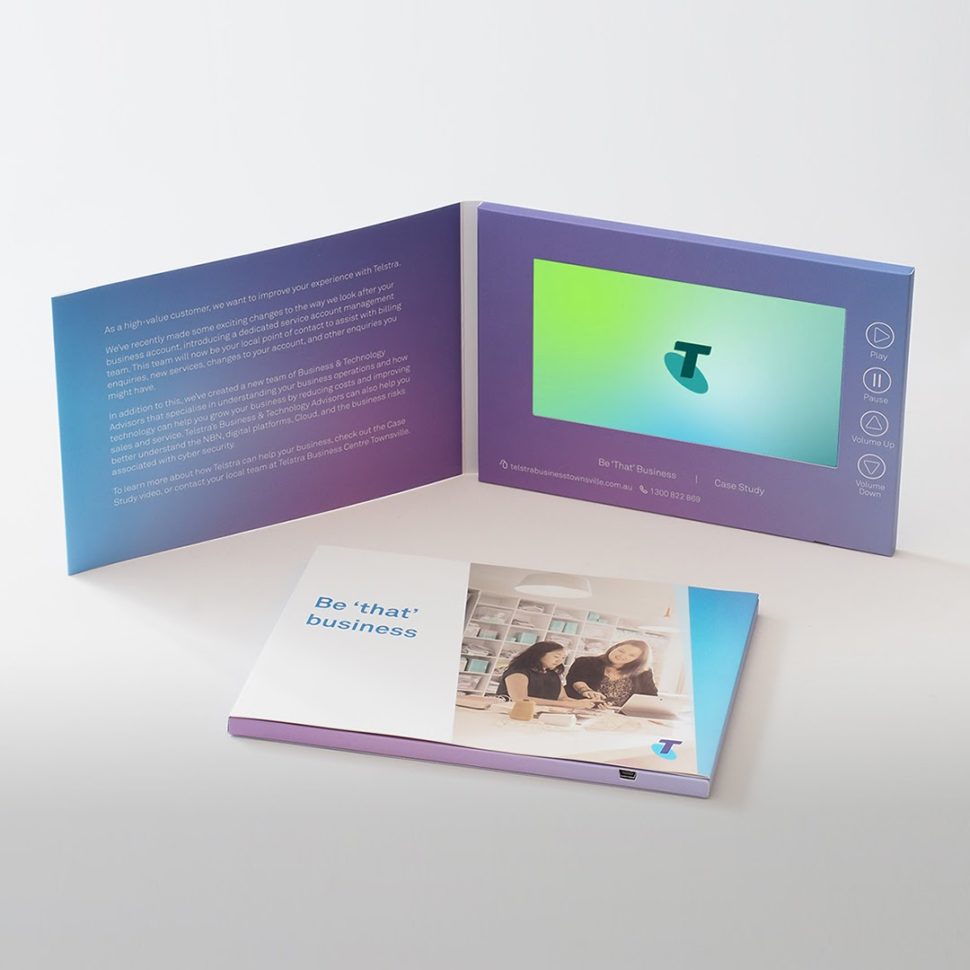
As the only instance where you can literally mail your video to potential clients, it’s hard to assemble a more memorable piece of direct mail.
Direct mail is experiencing a bit of a renaissance due to technology making printing more affordable, and innovations like these video brochures are making direct mail more attention-grabbing and memorable than ever.
If the cost of a full mailing blast is too high for you, consider ordering a smaller quantity and then handing them out at community events, any workshops you might host, or even as a parting gift when someone comes into your office for a consultation.
Conclusion
Each of these strategies, when used in combination, will create an impactful, widespread network of brand awareness that is sure to drive results, increase revenue, and positively influence your average case value.
It’s important to remember that your brand is not just your logo and the name of your law firm. It can’t be contained to just a business card. Your brand is every single way you project an image of your law firm to the world. Everything from the 30-second video you put on your YouTube channel to the way your staff treats incoming clients.
You can choose to have your brand either meet the bare minimum or truly reach and leave an impact on a wide audience. These 28 methods are a surefire means to achieving that reach.
The most important factor in every one of these steps, though, is the video – if it isn’t done well, these strategies will not have as much of an impact. In fact, it could potentially damage your SEO rankings, brand image, and reputation. More than anything, the most important aspect of a legal video marketing campaign is the partner you choose to produce your video. We hope you’re able to take advantage of these strategies to make the most impact with your legal video.

